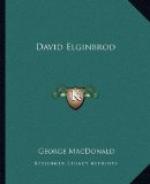“Then,” said Hugh, apostrophising the door, “I must watch you.”
As, however, it was not yet near the time when ghosts are to be expected, and as he felt very tired, he drank one glass of the wine, and throwing himself on the couch, drew Euphra’s shawl over him, opened his book, and began to read. But the words soon vanished in a bewildering dance, and he slept.
He started awake in that agony of fear in which I suppose most people have awaked in the night, once or twice in their lives. He felt that he was not alone. But the feeling seemed, when he recalled it, to have been altogether different from that with which we recognise the presence of the most unwelcome bodily visitor. The whole of his nervous skeleton seemed to shudder and contract. Every sense was intensified to the acme of its acuteness; while the powers of volition were inoperative. He could not move a finger.
The moment in which he first saw the object I am about to describe, he could not recall. The impression made seemed to have been too strong for the object receiving it, destroying thus its own traces, as an overheated brand-iron would in dry timber. Or it may be that, after such a pre-sensation, the cause of it could not surprise him.
He saw, a few paces off, bending as if looking down upon him, a face which, if described as he described it, would be pronounced as far past the most liberal boundary-line of art, as itself had passed beyond that degree of change at which a human countenance is fit for the upper world no longer, and must be hidden away out of sight. The lips were dark, and drawn back from the closed teeth, which were white as those of a skull. There were spots — in fact, the face corresponded exactly to the description given by Funkelstein of the reported ghost of Lady Euphrasia. The dress was point for point correspondent to that in the picture. Had the portrait of Lady Euphrasia been hanging on the wall above, instead of the portrait of the unknown nun, Hugh would have thought, as far as dress was concerned, that it had come alive, and stepped from its frame — except for one thing: there was no ring on the thumb.




